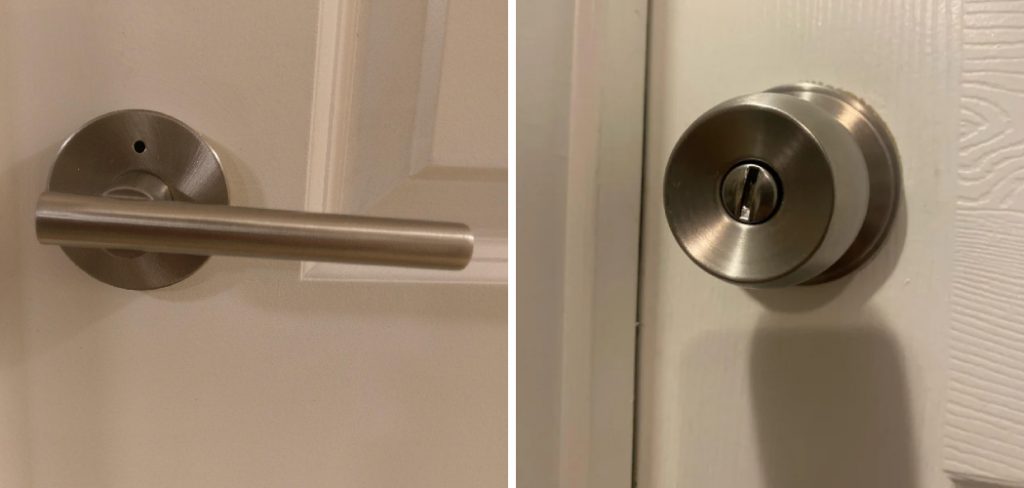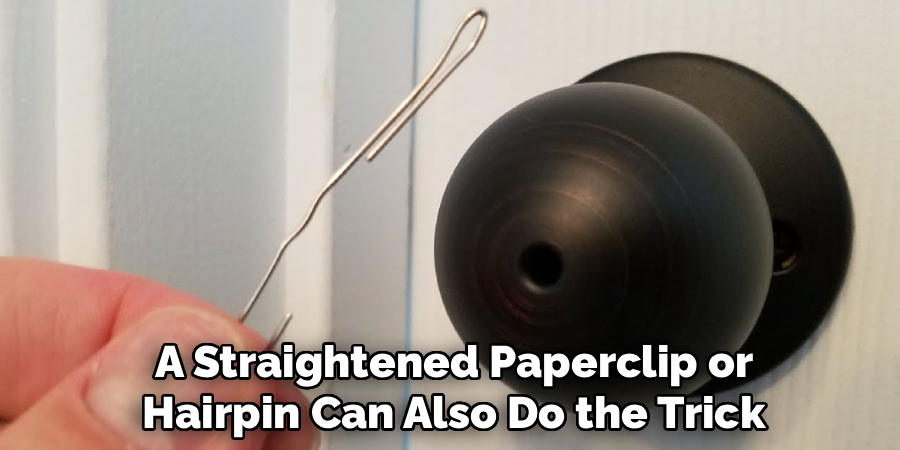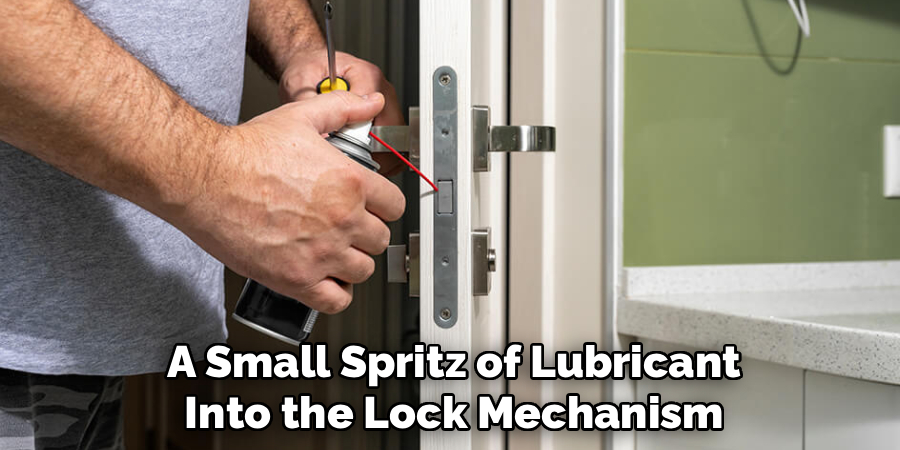Getting locked out of your bathroom is an inconvenience that can happen to anyone. Whether it’s a child accidentally twisting the lock or an internal malfunction, knowing how to unlock a bathroom door with a twist lock can save you time and stress.

This guide on how to unlock bathroom door with twist lock will walk you through the process step by step, explaining the tools you’ll need and precautions to take. You’ll learn some practical methods that often work without causing any damage. With a calm approach and the right information, you can handle this common situation efficiently and safely.
Tools and Materials You’ll Need
- Flathead Screwdriver (Small or Medium)
- Paperclip or Hairpin
- Butter Knife or Credit Card (Optional)
- Flashlight
- Thin Wire or Tension Wrench (Optional)
- Lubricant Spray (for Stubborn Locks)
- Cloth or Towel (to Protect Surfaces)
- Phone (in Case You Need to Call for Help)
8 Step-by-step Guides on How to Unlock Bathroom Door With Twist Lock
Step 1: Stay Calm and Assess the Situation
The first thing you should do is remain as calm as possible. Panicking won’t help you unlock the door faster, and a clear mind allows you to think through your options and choose the safest method.

Examine the door to confirm it is indeed a twist lock and to spot any potential damage or safety risks. If someone is inside, communicate with them to ensure they’re okay. This assessment will help you decide the best approach for unlocking the door safely.
Step 2: Locate the Exterior Lock Mechanism
Most bathroom doors with twist locks have a small slot or hole on the outside knob or handle. Sometimes, it may be hard to spot if the door or knob style is unusual, so inspect the hardware carefully.
The type of mechanism will determine the tool you use. Having a flashlight handy is helpful at this stage, especially if you’re working in a dim hallway or at night. Taking the time to identify the correct entry point increases your likelihood of success.
Step 3: Use a Flathead Screwdriver or Similar Tool
Insert a small flathead screwdriver into the slot or hole on the external side of the doorknob. Apply gentle pressure and twist the tool in the same direction you’d unlock the door from the inside.
If you feel resistance, wiggle gently rather than forcing it to avoid damaging the lock mechanism. Patience is important; sometimes several tries are needed before the lock disengages.
Step 4: Try a Paperclip or Hairpin for Push-Button Styles
If your twist lock includes a pinhole rather than a slot, a straightened paperclip or hairpin can also do the trick. Insert the straight end into the hole, pushing until you hear a click or feel the button depress.
Using a thin, rigid object allows you to manipulate the locking mechanism directly, releasing the door. If one tool does not work, try another with a similar shape or strength for better results.

Step 5: Employ a Butter Knife or a Credit Card (if Appropriate)
Sometimes, you may not have a flathead screwdriver or paperclip nearby. In those cases, a butter knife or an old credit card can be used with some care. Slide the tool gently between the door and the frame at the latch location.
Wiggle and press to try to push the latch back into the door. This trick works best on older or looser fittings, but always use caution not to bend or break your tool or harm the door’s finish.
Step 6: Apply Lubricant if the Lock Feels Jammed
Occasionally, twist locks stick due to grime or lack of use. A small spritz of lubricant into the lock mechanism can loosen stuck parts. Wait a few moments after spraying to allow the product to work.
Once the lubricant has settled, try your tool again. If the mechanism gives easily, proceed with unlocking; if not, reassess your approach to avoid damaging internal parts.
Step 7: Use a Thin Wire or Tension Wrench for Tricky Locks
If the lock resists simpler methods, you might be able to manipulate it with a piece of thin wire or a tension wrench, similar to basic lock picking. Insert the wire into the slot or hole, applying slight pressure while gently turning.
Move the wire around to find the turning mechanism, being patient and careful. While this method can take some time, it works on stubborn or older locks when other options fail.
Step 8: Know When to Seek Help
If none of these methods work or you’re concerned about damaging your door, don’t hesitate to ask for assistance from someone more experienced. Safety is always the priority, especially with certain types of doors that may have unique locking mechanisms.

Consider calling a locksmith if the situation calls for professional help. It’s better to pay for expertise than to risk injuring yourself or causing expensive damage.
Following these steps on how to unlock bathroom door with twist lock should help you successfully open your locked door without any issues. Remember to stay calm and carefully assess the situation before taking any action.
Do You Need To Use Professionals?
In most cases, unlocking a bathroom door with a twist lock can be done at home with basic tools and patience.
However, if you’ve tried several methods without success, or you notice the lock mechanism is broken or jammed beyond easy repair, it’s time to call a professional. Locksmiths are trained to handle a variety of lock types and will be able to open your door quickly and without damage.
Choosing professional help is the safest option if you’re worried about damaging the door or lock, or if the situation involves a child or vulnerable person inside. It also prevents voiding warranties on new or specialty locksets. Ultimately, when in doubt, professional assistance is worth the investment for safety and peace of mind.
How Much Will It Cost?
Unlocking a bathroom door yourself is usually free aside from the cost of basic tools, most of which you probably already have at home. If you need to purchase a small screwdriver or lock-picking tool, the expense is generally minimal.
However, if you end up hiring a locksmith, the cost can vary depending on your location, time of day, and level of urgency—typically ranging from $50 to $100 for simple jobs.
Emergency or after-hours services may increase the price. Additionally, if significant damage has occurred requiring part or door replacement, costs can rise accordingly. Knowing potential expenses ahead of time helps you make informed decisions about the right course of action.
Frequently Asked Questions
Q1: What Should I Do First If I Get Locked Out Of The Bathroom?
When you realize you’re locked out, the first thing is to stay calm and take a deep breath. Assess the situation carefully, checking if anyone is inside and whether the lock is engaged or stuck. Try to remember if there’s a simple way to unlock from the outside. Gathering the right tools and reviewing your options before acting helps avoid unnecessary damage or stress.

Q2: Can I Unlock The Door Without Any Tools?
In some cases, you might be able to unlock the door without tools, such as by twisting a coin in the slot or gently turning the knob with your fingers. However, most twist locks require at least a basic tool like a screwdriver, paperclip, or similar object. Having the right tool makes the process faster and less likely to cause harm to the lock or door.
Q3: Is It Possible To Damage The Lock Or Door While Trying To Unlock It?
Yes, it’s possible to accidentally damage the lock or the door if you use too much force or the wrong type of tool. Bent or broken parts can make the problem worse and lead to expensive repairs. Always use gentle pressure and patience, switching methods if something doesn’t work. If you’re unsure, it’s best to call a professional to avoid further damage.
Q4: Are There Alternatives To Calling A Locksmith?
If you’ve exhausted all safe unlocking methods and are still unable to access the bathroom, you might ask a handy friend or family member for help before calling a locksmith. Some building managers or maintenance staff may also respond quickly if you live in an apartment or condo. Only turn to a locksmith when other reasonable options have failed and it’s the safest route.
Conclusion
Unlocking a bathroom door with a twist lock is a manageable task if you understand the mechanism and use the right tools. By following these detailed steps on how to unlock bathroom door with twist lock, you can resolve most situations calmly and without causing damage.
Remember, patience and safety are key. Keep some basic tools handy for emergencies, and don’t hesitate to seek professional help when needed. With a little preparation and knowledge, you can confidently handle lockouts and keep your bathroom accessible to everyone in your household.
About
Safety Fic is a distinguished figure in the world of Diy design, with a decade of expertise creating innovative and sustainable Diy solutions. His professional focus lies in merging traditional craftsmanship with modern manufacturing techniques, fostering designs that are both practical and environmentally conscious. As the author of diy, Safety Fic delves into the art and science of Safety Fic-making, inspiring artisans and industry professionals alike.
Education RMIT University
(Melbourne, Australia) Associate Degree in Design (Safety Fic) Focus on sustainable design, industry-driven projects, and practical craftsmanship. Gained hands-on experience with traditional and digital manufacturing tools, such as CAD and CNC software.
Nottingham Trent University
(United Kingdom) Bachelor’s in diyfastly.com and Product Design (Honors) Specialized in product design with a focus on blending creativity with production techniques. Participated in industry projects, working with companies like John Lewis and Vitsoe to gain real-world insights.
Publications and Impact
In diy, Safety Fic his insights on indoor design processes, materials, and strategies for efficient production. His writing bridges the gap between artisan knowledge and modern industry needs, making it a must-read for both budding designers and seasoned professionals.
